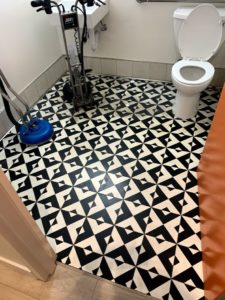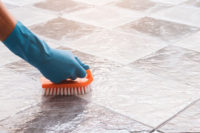We see it all the time: customers spend ages scrubbing their tile floors only to walk away with cloudy soap stains and smears of dirt (or worse – damage). Here, we talk you through how to clean different types of tile from start to finish.

If your tile floor is in need of a little more love, or you just can’t seem to get your tile and grout sparkling clean, ask our team about our professional tile cleaning service.
Follow these 8 steps to learn how to clean tile floors.
1. Identify the type of tile
Before you begin, make sure you know what kind of material your tile floors are made out of. Certain cleaning products and methods can permanently damage some materials (like natural stone tiles), while others (like ceramic) are more versatile.
How to clean…
- Ceramic and porcelain: Incredibly durable, respond well to homemade cleaners (such as baking soda or white vinegar) as well as professional cleaning products
- Natural stone (such as slate, granite, or marble): Fairly sensitive, use mild detergent and avoid acidic cleaners, harsh chemicals, or tough brushes as they can damage the surface
- Vinyl: Fairly durable, respond well to homemade cleaners and gentle detergent, don’t use harsh scrubbing tools as they can leave scratches
- Linoleum: Requires specific linoleum cleaning solution and protective waxing every 3-6 months
2. Vacuum the area
Start by vacuuming the area thoroughly (check out our how to vacuum guide for more tips). Use the appropriate attachments to get into hard-to-reach areas and be sure to spend some time tackling dust and dirt that has collected in the grout between the tiles.
3. Prep the best tile and grout cleaner
 Remember – the best tile and grout cleaner depends on what material your tiles are made of.
Remember – the best tile and grout cleaner depends on what material your tiles are made of.
If you’re cleaning natural stone tiles, avoid acidic ingredients and harsh chemicals. Opt for mild detergent or look for professional cleaning products that has been made specifically for your type of tiles and follow the manufactures’ instructions.
For durable tiles like ceramic, porcelain, vinyl, or laminate, you can make a homemade cleaning solution: fill a bucket with one gallon of warm water and 1/2 c of white vinegar. Alternatively, mix a mild detergent with warm water.
Check out ecolife’s natural cleaner recipes for more ideas (just make sure you vet them based on your tile material beforehand!).
4. Use the right tools
There are many different types that will get the job done, from classic string mops to flathead styles.
Look for one that will spread and absorb your cleaning solution evenly, without leaving residue between grout lines – avoid sponge mops, as they tend to push dirty water aside, rather than effectively absorbing it.
5. Apply the products (with care!)
First, plan your route so you don’t mop yourself into a corner! Dip your mop in the cleaning solution so it’s damp, but not soaked. Avoid scrubbing – apply steady pressure so you can clean an area evenly.
Work your way around the room, section by section (yes, not just on the mucky bits). Keep an eye on the water – when it goes cloudy, change it and continue until you’ve covered the entire floor.
6. Dry the floor
We know: you’re probably feeling a bit tired from mopping – but don’t skip out on this step. Leaving your tiles to air dry can result in water splotches and soap rings.
Use a clean, dry cloth to go over the area. There’s no need to get on your hands and knees – if you have a dry mop head, attach that and wrap the cloth around it. Otherwise, there’s always the classic use-your-foot option.
7. Plan your grout cleaning
Clean, sparkling tiles are only beautiful if your grout is also in good shape. If it looks like it’s in need of a refresh, we’ll talk you through how to clean grout:
- Create a paste using baking soda and water (unless your tiles are made of natural stone)
- Apply it to the grout
- Scrub the area in the morning with a brush (remember – don’t use a hard brush on natural tiles)
- Mop your floor
8. Repeat regularly
Now you know how to do it, it’s important to know but how often you should clean tile floors:
- Sweep or vacuum tile floors at least once a week
- Mop kitchen tiles (and other common rooms) at least once every two weeks
- Mop bathrooms at least once a week
- Clean grout every 4-6 months
Is professional tile cleaning worth it?
One you know how to clean your tile floors, regular maintenance will keep your tile looking fresh and presentable. Over time, they will still need a deep clean to tackle the dirt, dust, oil, grease, and bacteria that gets ground in every time you walk on your floors.
When deciding how to clean tile floors, professional cleaners will use specialized equipment for your specific tile materials, to soak, scrub, and extract dirt and stains.
We offer restoration services, where we can tackle extremely dirty tiles and grout and remove as much staining as possible. We can also reseal the area when it’s dry, to protect your tiles and grout for longer.
How often should tile floors be professionally cleaned?
Get your tile floors cleaned annually, to keep their sheen and maintain their quality appearance.
What do professionals use to clean tile floors?
 The materials and tools professional cleaners use will vary greatly. We only use planet-friendly products and practices, including:
The materials and tools professional cleaners use will vary greatly. We only use planet-friendly products and practices, including:
- Natural One Earth cleaning solutions
- Hydroforce Hard Surface rotary cleaner
Learn more about our products and equipment.
If you’re ready to get an oh-so-satisfying deep clean of your tiles and grout, reach out to our team for a quote. Not sure what your floors need? Learn about the difference between dirt and damage.
Request a Quote
We’ll be in contact with you shortly to give you an estimate.
